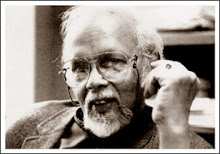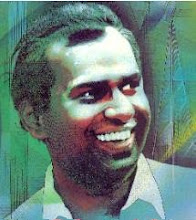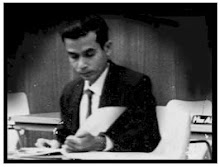Matured artist advices the nation on
Author: Ranga ChandrarathneSource: Sunday Observer
| |
She is one of the best stage actresses ever produced who took part both in stylised and realistic plays. I still remember her character old woman in Prof. Sarachchandra's semi-stylised play "Raththaran", as a member of the original cast, as her best portrayal.
Her acting was highly impressive even as an undergraduate, in her long history an actress especially in Sarachchandra's and Gunasena Gallapaththi's days remarked Prof. Ariya Rajakaruna. One of the most exciting actresses I have encountered in my life, Dr. Lakshmi de Silva, former Head of the Department of English, University of Kelaniya.
****
An artist should be committed to social justice and to his/her own conscience, otherwise he/she is a mere entertainer states veteran actress and theatre personality Somalatha Subasinghe citing an example of a farmer who considers his soldier son as an object to acquire basic human needs.
The protracted war has completely changed the basic norms of humanity, even eroding the parental love towards children.
|
|
| |
| |
She questions how long an artist with a conscience can be deaf and blind to the situation. Artist should commit to conscience and social justice.
Her forte in art and theatre is children's play which is an almost neglected but an important area in contemporary Sri Lankan theatre. Her dramas for children are always tied up with a moral lesson beyond the storyline that teaches children to think rationally, recognizing social justice in order to make children good human beings with leadership and rational thinking.
Through the Lanka Children's and Youth Theatre Organization (LCTYO), a voluntary organization she founded in 1981, Mrs. Somalatha Subasinghe attempts to reach the children of grass root level with a view to enhance their creativity.
She believes that every child should be happy and next to the food and shelter, the play can teach children many lessons; theatre has a healing and therapeutic effect on Tsunami affected children, especially those who lost their parents.
Referring to the application of art and culture in Sri Lanka, she is of the view that it should be honest without any prejudices. The pieces of art which intend to promote and foster certain cultural vales should go on with a label for a certain age group and that those who wish to watch should be allowed to do so.
However, the authorities can not decide whether a piece of art or film should be viewed or not. Who has decided Sulaga Enupinisa (The Forsaken Land) a bad film The film is not suitable for children as they could not grasp the symbolic statement in the film.
The film shows what would happen to human beings when war has taken away what they had. There is a possibility of human beings assuming the characteristics of animal behaviour in such an arid environment.
It is ironic while the newspapers carry in full stories where father rapes daughter, the serious works of art is prohibited to exhibit in the name of culture and allegedly degrading the moral of the armed forces.
As far as Sulaga Enupinisa (The Forsaken Land) is concerned, she believes that nothing degrading or humiliating of the armed forces whose prime duty is to protect the nation, has been done in portraying a scene where a home-guard is thrown into a river for sheer fun by the patrolling group of soldiers.
The situation has turned the human being into animal nature and the animal instincts work. She attributes the uproar over Sulaga Enupinisa to a mean understanding of symbolism. This is the result of people not being exposed to classical art and also not learning to appreciate fine works of art.
Commenting on Aksharaya , she opined the incident in the nature of what happened in Aksharaya could happen and there is no precedent that common occurrence should always be incorporated into a work of art. Duty of the artist is to warn the society of possible scenarios that could have happened.
Among the characters she played on the silver screen, Somalatha Subasinghe likes the role she played in Viragaya which she described as one that she immersed herself in.
The most inspiring iconic figure, for Somalatha Subasinghe, in Sri Lankan theatre was Professor Ediriweera Sarachchandra. He brought up a whole nation together and his commitment to theatre was awe-inspiring. In the early days of his career at Peradeniya, Professor Sarachchandra was always out on an assignment even skipping meals.
He led a very frugal life. Most of his time, he spent in researching and creating works of art. Prof. Sarachchandra encouraged her and left a lasting influence on her career in theatre.
As she was fortunate to cross paths with almost all the veterans in the field of theatre including Gunasena Gallapaththi and Dhamma Jagoda, She played lead roles in their classical productions such as Sarah in Gunasena Gallapaththi's Muhuduputtu and Jessica , Liya Thambara by Ranjith Dharmakeerthi, Henry Jayasena's Diriya Mawa Sinhalese translation of Mother Courage, Ranavishkaya in Cherry Orchard and Kumari in Dhamma Jagoda's Vesmunu. Those roles were like Universities and the directors were bi-lingual and experimented with the theatre.
According to Somalatha Subasinghe, she is influenced by Prof. Sarachchandra, veteran dramatist Gunasena Gallapaththi and German Playwright Bertolt Brecht and Buddhist Philosophy. Brecht said when you talk about your mother, look at her as your father's wife. Buddha said that take the veil off your eyes when you look at a problem.
The objectiveness in Brecht's theatre is being applied by Somalatha Subasinghe in her productions. Being objective while engrossed in a character is one of the daunting tasks that an actor is entrusted with. On one occasion, she advised her daughter Kaushalya Fernando not to get emotionally involved in the character. Brecht's theatre application of alienation is now applied worldwide.
This is perceived even in Hollywood. Speaking on her children, she said though her second daughter Shyamalika played the lead role in Vikurthi , she had to disassociate with theatre after marriage and bore children.
Shamalika is a sharp critic and her point of view is always taken into consideration. Her brother analyses the roles she played from a realistic perspective and a Marxist point of view. It is Marx who has said that your creativity will be used as an instrument by the powers be. With the emergence of computer, manual creativity is no longer needed. She is of the view that creation of art was originally made manually.
That is the genuine. Commenting on the artists in Sri Lanka, she said only a few of artists analyze the social and political situation,though thay have no performing space, in the country through their creations while a section of the artists are either brainwashed by the system or subservient to the establishment. This section of artists prevents serious artists from analyzing the society through their works of art.
One friend expressed dismay at allowing Kaushalya to play a role in Sulanga Enupinisa and questioned her whether she repent the decision. Somalatha's reply was that nudity can also be used in art to portray something demanded by the character and convey some message. Such portrayals become uncivilized if the nudity is exposed for her gratification.
Sri Lanka has become a hypocritical nation which denied the existence of sincere human nature. It is ironical that adults force the children to hold placards against child abuse.
Although Kaushalya, Shyamalika and her husband Priyanka extend their helping hand to Somalatha, it is her son-in-law, Senior Lecturer in Economics, at the University of Colombo; Dr. Chandana Aluthge has been a live-wear behind major house-hold operations and stands tall as a pillar of strength behind Somalatha.
As she grew up in a family of teachers; father, a principal and mother, a teacher, naturally, Somalatha followed the parents footsteps in becoming a teacher herself. It was an atmosphere dominated by indigenous forms of art ranging from traditional dance to music which flourished under the state patronage of the British. The British of the day had also encouraged agriculture.
Her father sent her to Museus College while her brother D.W. Subasinghe was sent to Ananda College to learn English. He grew up to be a committed communist.
Socialist political ideology has greatly influenced her work and radical application in art. Though she could not campaign alone, she firmly believes that the artists should rise against any form of oppression and especially to protect the young talented artists who create great work of art and the freedom to express them.
Profile of an outstanding artist
1982 Vikurthi (Distortion) an original play focusing on the problems of the education system of Sri Lanka.
1985 Para Haraha (Across the Road) an original play based on the conflict between traffic and pedestrians.
1986 Sanda Kinduru (Buddhist theme) written by Gunasena Galappatthi, staged in collaboration with Sujatha Vidyalaya, subsequently for television - drama.
1990 Mudu Putthu (Yerma by Garcia Lorca) adaptation by Gunasena Galappatty
1990 Pawara Nuwarak (city of Fame) Adaptation of a Sinhala classical poem as a contemporary social comment
1991 Opera Wanyosi of Wole Soyinka (Adaptation as a trilingual Play-English/Sinhala/Tamil in collaboration with Dept. ofEnglish, University of Colombo.
1992 The Trial of Dedan Kimathi by Nugugi Wa Thionogo and Micere Gitahe Mugo Production in English in collaboration with the British Council, Colombo.
1992 Yadam (Chains) Sinhala Translation of The Trial of Dedan Kimathi by Nugugi Wa Thionogo.
1993 Antigone by Sophoclese Sinhala Production Translated from English translation by E. F. Watling
1998 Mavakage Sangramaya Sinhala Translation of Mother Courage and Her Children by Bertolt Brecht, in collaboration with German Cultural Institute to commemorate 100th birth anniversary of Bertolt Brecht.
Children' Theatre
1979 Punchi Apata Then Therei (We Know It Now)
1979 Thoppi Welenda (Hat Seller)
1981 Gamarala Divya Loketa (Gamarala Going to Heaven)
1981 Rathmalee (adaptation of Red Riding Hood)
1988 Ottooi (Challenge)
1995 Hima Kumariya (adaptation of Snow White and the Seven Dwarfs)
2003 Walas Pawula (adaptation of Goldilocks and Three Bears)
****
Lanka Children's and Youth Theatre Foundation (LCYTF)
Lanka Children's and Youth Theatre Organization (LCYTO) is a voluntary organization founded in 1981 by Mrs. Somalatha Subasinghe, the veteran playwright and theatre director, under the laws of Sri Lanka with a view to further the cause of children's theatre in Sri Lanka.
It was also meant to fill the vacuum of the necessity of a drama institution in the country. LCYTO recruits young men and women with high school qualifications solely on the strength of their commitment to theatre. Some of them are basic degree holders too.
They are sent through a systematic course of training in drama and theatre arts along with training in the traditional drama and dance forms of Sri Lanka. The normal theatre style in Sri Lanka being that of total theatre, the average Sri Lankan actor/actress has to acquire training in Sri Lankan dance drama too.
LCYTO has become the only one of its kind in Sri Lanka, which produces mainly musical plays for children and youth, with professional actors, and it has also emerged as one of the leading sources of training centres for performing artistes particularly in children's theatre.
The high standards set and maintained by LCYTO in their productions has opened avenues for the professional theatre group to perform and participate in many international children's and youth theatre Festivals and conferences in many different parts of the world.
The professional theatre group of LCYTO also performs mainstream theatre with the objective of improving their skills. It has produced a number of award winning and highly acclaimed mainstream theatre productions.
LCYTO was conferred the Bunka Award presented by the Embassy of Japan for the Best achievement in Performing Arts in 1997. Actors/actresses and other creative artistes who were trained at LCYTO, work on their own and for other directors and that LCYTO members have won many awards for their performances at the State Festivals in stage drama, television as well as cinema.
The year 2001 State Drama Festival was one such special occasion where six of LCYTO actors and actresses and other creative personnel carried away awards for direction, acting, script writing, costume designing, staged,cor and music as well.
In 2004 Kaushalya Fernando, one of the directors of Play House-Kotte, bagged the prestigious Bunka Award for special achievement in Theatre and Acting.
LCYTO became an incorporated foundation called Lankan Children's and Youth Theatre Foundation (LCYTF) by an Act of Parliament (Act no. 3 of 2007) on 29th January 2007.








































I'm looking for contact with actress Kaushalya Fernando. I met her 20 years ago on the way back Colombo-Amsterdam.Ans Kok
ReplyDeleteanskok@viltkunst.com